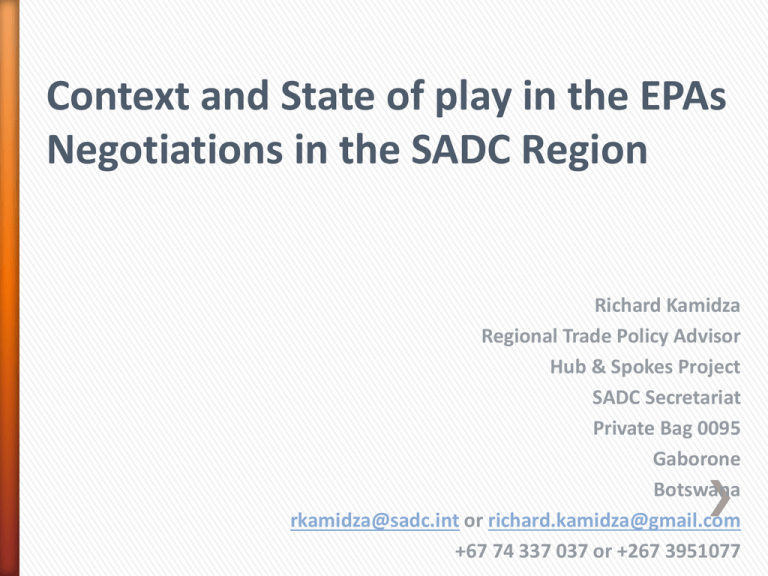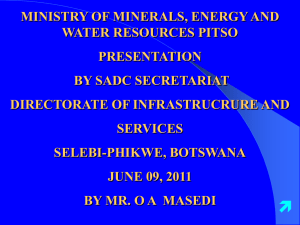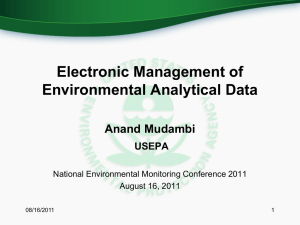view documents
advertisement

Context and State of play in the EPAs Negotiations in the SADC Region Richard Kamidza Regional Trade Policy Advisor Hub & Spokes Project SADC Secretariat Private Bag 0095 Gaborone Botswana rkamidza@sadc.int or richard.kamidza@gmail.com +67 74 337 037 or +267 3951077 Structure of my Presentation 1. Introduction 2. ESA / SADC EPAs Negotiating structures 3. Context & State of Play in the EPAs process • EAC Current Status • ESA Current Status • SADC EPA Current Status 4. EU market Access Regulation 1528/2007 5. What should stakeholders do? 6. Conclusion Introduction EU-ESA Configuration joint roadmap was launched in February 2004, in Mauritius; EU-SADC EPA Group joint roadmap was launched in July 2004, in Namibia; However, EPAs divided Africa into 4 fragmented & vulnerable configurations: • ECOWAS; CEMAC; ESA; & SADC; SADC Member States (See table below); Sao Tome & Principe Gabon Cameroon, Chad Central African Republic, Republic of Congo CEMAC GROUP Equ. Guinea DRC Angola SADC Mozambique Tanzania SACU Botswana Lesotho Namibia South Africa SADC EPA GROUP KEY SADC COMESA SACU Ioc EAC CEMAC Swaziland Burundi Kenya Uganda Rwanda Djibouti Eritrea Ethiopia Sudan – Southern African Development Community – Common Market for Eastern and Southern Africa – Southern African Customs Union – Indian Ocean Commission – East African Community – Economic Community of Central African States EAC EASTERN & SOUTHERN AFRICAN EPA GROUP Malawi Zambia Zimbabwe Mauritius Seychelles COMESA Comoros Madagascar IOC Overlapping between different regional integration processes in Southern Africa and new groups formed for the purpose of negotiating Economic Partnership Agreements (EPAs) with the European Union Introduction (Contd.) Major objectives of EPAs negotiations are: • To be an instrument of sustainable development; • To support regional integration among the ESA or SADC EPA Member States or SADC region; • To be compatible with WTO rules (outcomes must progressively abolish substantially all trade restrictions); • To take into account different needs and levels of development of contracting parties (EU & ESA or SADC EPA countries) by providing sufficient scope for flexibility, special & differential treatment & asymmetry, especially on LDCs, small & vulnerable economies, landlocked & small island countries; • To contribute to poverty alleviation (reduction); • To support the integration of ESA & SADC EPA countries into the world economy; ESA / SADC EPAs Negotiating structures ESA & SADC EPA configurations’ negotiating institutions/structures: Regional Secretariats (COMESA & SADC EPA Unit) – central to the process; Chief Technical Advisor (CTA); National Development Trade Policy Forum (NDTPF); Regional Negotiation Forum (RNF); Regional Preparatory Task Force (RPTF); Committee of Ambassadors ; Council of Ministers - for political direction, decisions & guidance; All the above are supported by the EU; European Union’s negotiating structures; The European Commission • Director General – Trade • Director General - Development ESA / SADC EPAs Negotiating structures (Contd.) ESA / SADC EPAs Negotiating structures (Contd.) Context & State of Play in the EPAs process Configurations’ challenges include: Lack of deep & wide consultations with all stakeholders (producers, exporters, fisher-folk, consumers, farmers, etc.); Difficulties in accessing promised development resources to redress supply-side constraints; Minimal (or lack of) sharing positions, interests, issues or offers at between negotiators and other stakeholders including MPs; Lack of public support for the EPAs which makes the ACP politicians vulnerable should they go ahead to sign it in its current form (according to the SADC EPA Brussels Ambassadors’ Report); No comparison of positions & offers between SADC EPA, COMESA & the EAC Groups; Division within groups as some countries signed Interim EPAs while others opted out (see table below); Context & State of Play in the EPAs process (Contd.) EPAs Signatories EPA Signatory states in December 2007 (LDCs in red) Countries which did not sign but falling into EBA/standard GSP Proportion of signatory countries Number of liberalisation schedules ESA Comoros Madagascar Mauritius Seychelles Zimbabwe Djibouti Eritrea Ethiopia Sudan Malawi Zambia 45% 5 EAC Burundi Kenya Rwanda Uganda Tanzania — 100% 1 SADC Botswana Lesotho Mozambique Namibia Swaziland Angola South Africa 71% 2 CEMAC Cameroon Chad Cent. African Rep. Congo DR Congo 12.5% 1 Eq. Guinea Gabon S. Tomé/Principe Context & State of Play in the EPAs process (Contd.) • IEPAs have: – produced separate tariff-elimination commitments or schedules; – produced different tariff-elimination schedules from the SADC Free-Trade Area, a development that has the potential to undermine the regional trade & integration agenda; – generated tensions within the SADC-EPA group; – generated direct negative implications to SACU; Current Status »EAC-EC Experts met on 15–17 November 2011 & discussed: ˃ Rules of Origin; ˃ Economic and Development Cooperation; ˃ Agriculture; ˃ Parties agreed that Trade in Services and Trade Related Issues would be negotiated at a later stage. However, the EC proposed that Trade, Environment and Sustainable Development be considered as this is a requirement by the EU Parliament in all agreements concluded by the Commission; • EAC Secretariat organised meetings for Member States with COMESA Chief Technical Advisor (Nairobi); & SADC Secretariat officials (Burundi) to compare areas of convergences & divergences in the rules of origin text; » On 12-15 December 2011, the Joint Technical & Senior Officials met in Brussels, Belgium & considered the following: + Economic and Development Cooperation; + Rules of Origin; + Agriculture; + Dispute Settlement and Institutional Arrangements; + Trade, Environment and Sustainable Development; + Roadmap to finalize the Comprehensive EPA negotiations; + New issues that were submitted by Mid-November 2011; » According to SADC EPA Brussels based Ambassadors’ Report, EC has intensified contact with this region on: + Development Cooperation; + Agriculture; + Rules of Origin; ESA Current Status New Momentum & Progress at the Joint EU-ESA technical negotiating session held in Mauritius in November 2011: On trade in goods: Parties reached agreement on all provisions on SPS; TBT trade facilitation; capital movements; general & specific security provisions; and previous contentious provisions regarding most favoured treatment (MFN); On the text on services: Parties reached agreement on Articles on principles (including on variable geometry), market access; other agreements; sections on tourism & travel; postal, maritime and computer services; & chapter on capital movement. On most definitions, EU to clarify footnote & definition of enhanced mode 4; On trade related issues: Parties reached agreement on all provisions on competition policy; on working on those aspect relating to technical cooperation & capacity building; and on working on the basis of a joint text on sustainable development; On texts on agriculture and development, agreement delayed by few issues; Outstanding & contentious issues by cluster include: With respect to development cooperation, two key issues are: Additional resources; and linking trade liberalisation to development benchmarks; With respect to trade in goods issues include: provisions on substantial all trade liberalisation; timeframes for liberalisation; treatment of export taxes; agricultural safeguards; On export taxes, technical teams are considering language that allow consultative process BUT without limiting the policy space of ESA countries to impose export taxes; On agriculture: Parties reached agreement to refer the issue of export subsidies to the political level (Council of Ministers); On Agricultural safeguards, since agricultural export subsidies are being discussed under WTO, ESA position is that the issue should be left for political tradeoffs at an appropriate time; On rules of origin cumulation provisions, EU submitted proposal on cumulation on materials which are MFN 0%; diagonal and full cumulation with other EPA signatories and OCTs; cumulation with GSP zero and quota free materials; & extended cumulation with industrial materials which are duty free quota free under EU FTAs; ESA welcomed the proposal, but would like to preserve cumulation with ACP states; reduce the list of products excluded from cumulation with South Africa; & cumulate with neighboring countries including Egypt which is in COMESA FTA; On trade in services EC to revert with new positions or proposals on Articles on MFN & MFN exceptions; new financial services; anti-competitive practices & safeguard measures; ESA to respond to EU’s proposals on telecommunications & e-commerce; On trade related issues, ESA agreed to prioritise competition policy & sustainable intellectual property rights ahead of public procurement & good governance on tax matters; Implementation of interim EPA Madagascar, Mauritius, Seychelles & Zimbabwe that signed interim EPA have now ratified it, & soon will come into effect after Zimbabwe deposited the ratification instruments; interim EPA covers 5 main subjects: trade in goods; fisheries; development cooperation; dispute settlement; and final provisions; Focus is on supporting the countries to implement the commitments including: undertaking needs assessment on legal framework & administrative/human resource requirements; domesticating IEPA in national laws including the customs book; assistance towards establishing a “national EPA Implementation Unit”; Pursuing accompanying measures to finance EPA-related adjustment costs including capacity building, modernization & re-structuring of industries affected by trade liberalization; and awareness programme to inform all stakeholders (civil society & the business community) on the rights, obligations & opportunities contained in the interim EPA; SADC EPA Current Status New Momentum & Progress at the Joint EU-SADC EPA Senior Officials negotiating session held in Pretoria, South Africa on 23-30 May 2012: Market Access with EU coverers three regimes: • SACU, Angola, & Mozambique; EC’s draft text proposal provides for bilateral and diagonal cumulation. SADC EPA Member States are required to put in place Administrative Cooperation arrangements that allow cumulation with one another; & other ACP States, OCTs and other preferential partners of EU before cumulation can enter into force [Negotiations on Administrative Cooperation continue]; EC’s compiled a list of products to be excluded from cumulation within the SADC EPA Member States’ respective territories that largely contains products with South African origin which do not enjoy duty-free quota-free access into the EU market; Similarly, the SACU region has compiled a list of products to be excluded from cumulation; [The two parties are yet to decide on the principle and approach on this issue]. On Rules of Origin for fisheries relating to Exclusive Economic Zones, Right of First Refusal & derogation for tuna, SADC EPA States forwarded a proposal to the EC; [Discussions are continuing] On Agriculture & Non-Agricultural Market Access (NAMA), EC submitted a list of request & offer for the SACU market in May 2011. SACU submitted its counter-offer, which was considered in the SADC EPA Senior Officials meeting of November 2011. [Parties could not reach agreement on the offer, hence negotiations on NAMA & Agriculture will continue in the next round]. SADC EPA Current Status (Contd.) Unresolved Issues Outstanding Issues Action Art. 22: Standstill SADC EPA to propose the language Art. 23 ter: Infant Industry SADC EPA to react to EC proposal Art. 24: Export taxes For discussion in the next Joint meeting Art. 28: MFN EU to consult on the principle point raised by SADC EPA Art. 29: Special Provisions EC to propose language that addresses SADC on Administrative EPA’s concerns of unilateral action or Cooperation approaches; Art. 34: Bilateral Safeguard Measures EU to consult given SADC EPA’s proposal on “MFN rate as applied at the time the measure is taken” instead of “MFN rate applicable at the time of entry into force” Annex 6: Agricultural safeguard Measures To be considered within the context of Market Access negotiations SADC EPA Current Status (Contd.) Unresolved Issues (Contd.) Outstanding Issues Action Art. 114: Rights and Obligations under this Agreement SADC EPA to react to EC proposal Art. 34 (5): Agricultural Safeguards This was noted to have broader implications to the sector and the economy [To be considered in the next joint meeting]; New Generation Issues o Competition Policy; o Protection of Intellectual Property; o Transparency and NonDiscrimination of Public Procurement; o Cooperation in the Tax Area SADC EPA to react to EC’s texts; & SADC EPA requested EC to react to its last year’ submitted texts; Geographical Indicators This was noted to be for the ongoing EC South Africa bilateral negotiation; SADC EPA Current Status (Contd.) Trade in Services & Investment EU submitted a new Article on Services & Investment proposal that presupposes that negotiations on services & investment will not be concluded by the time the full EPA will be agreed . Therefore, parties agreed to: • exchange requests & offers not later than 31/12/2013; • conclude negotiations by 31/12/2015; • Proposal silent on long-held position by participating SADC EPA States that an agreement on investment should only extend to cooperation; • EC want negotiations on regulatory provisions whereas participating SADC EPA States have been generally open to consider regulatory provisions as part of the negotiations on specific commitments; • EC language is not mandatory when it comes to issues of cooperation and special & differential treatment; • Participating SADC EPA States questions EU’s motivation to table the services text when negotiations are underway; • Parties to consider texts (both services and investment texts) as submitted by each side and exchange comments by the end of July 2012. Trade related Issues EC submitted proposals on Competition Policy; Protection of Intellectual Property; Transparency & Non-Discrimination on Public Procurement; and Cooperation in the tax Area. But SADC EPA States argues that EC’s proposal goes beyond ‘cooperation language’, link development cooperation provision to some obligations; and ignores the group’s comments on cooperation texts. Programme of activities for the EPA negotiations Date Activity Responsible Submission of 1st Draft End of June EC Consolidated Text 18-19 July Joint TWG Market Access End of July Exchange of comments on Unresolved Issues Joint TWG Market Access (Rules of Beginning of Origin) September Joint TWG Services First week of October Joint Senior Officials EC to send data by 22 June Issue(s) Venue - - Agriculture & NAMA Everything EC & SADC EPA Consolidation of Texts All outstanding Market Access issues; Unresolved Issues; Services & Trade related Issues SADC EPA Region Introduction Members of European Parliament in the International Trade Committee voted in favour of EC’s proposal to update the Generalized System of Preferences scheme by removing preferences for EU imports from countries on World Bank’s high or upper middle per capita income list. Subsequently, EU issued a notice to withdraw market access regulation 1528/2007, an instrument adopted by EU on 30/9/2007 to extend duty free quota free market access to ACP countries that either signed or initialed the interim EPA; Implications of the regulation repeal ACP countries including ESA & SADC EPA that have not ratified or notified provisional application of their interim EPA by 1 Januray 2011 will no longer benefit from this regime; Main casualties in SADC region are some SADC EPA Member States: ˃ Botswana & Namibia, which are classified as upper middle-income, no longer qualify for EU market access under the new GSP provisions & have no longer have any recourse when implemented; ˃ Swaziland though is eligible to benefit from the GSP scheme, will see her sugar, the main export commodity, facing higher tariffs when entering the EU market; ESA non-LDCs (Mauritius, Seychelles & Zimbabwe) have already either ratified or notified provisional application of the interim EPA (no effect is expected); LDCs can still access EU market under similar regime – EBA (impact of the withdrawal is next to zero); Lobbying work by SADC EPA Ambassadors based in Brussels: Led by Namibia as the current chair of the ACP Southern African region & Botswana as the current coordinator of the SADC EPA Group, they: ˃ held meetings with the European Parliament in Brussels to review the proposed amendment to the EC Market Access Regulation 1528/2007; ˃ held meetings with some Members of the European Parliament (MEP) Committee on International Trade on the same regulation; ˃ Adopted a multifaceted lobbying process by engaging: + MEPs during the Joint Parliamentary Assembly in Denmark; + EU Ministers & Council during the Joint ACP-EU Council meeting in Vanuatu; + encourage SADC EPA Ambassadors based in EU Member States Capitals to be involved; Lobbying strategy to target: European Council, which will final vote around September 2012; EU Ambassadors based in the SADC EPA Capitals; European MPs, President of the European Parliament, Chairperson of the European Parliament; 7th Summit of ACP Heads of State and Government, in Malabo, Equatorial Guinea, 10-14 December 2012; Lobbying message: (i) mutually beneficial agreement; & (ii) extend negotiations conclusion to 1 January 2016; What should MPs do? Strategically link with: national & regional negotiators, national & regional institutions working on this area; development partners working on this area; Monitor: how negotiators summarise national interests, positions & offers before or after each major EPA group meeting to the nation; how negotiators share information on EPA processes & outcomes with key constituencies & citizens; harmonisation of liberalisation schedules with other regional commitments; the implications of EPA processes & outcomes to regional trade & integration agenda; Advocate for: support to institutions that develop knowledge, skills & capacities to simultaneous deal with bilateral & multilateral trade negotiations; the building of multi-stakeholders’ synergies, coalitions & partnerships with a view to ensure fair publicity & scrutiny of the process & outcomes; Conclusion Engage on the implications of EPAs to regional integration since; most LDCs have opted to stay out of the EPA process; signed EPAs have turned out to be bilateral arrangements with individual Member States; In ESA region, there are four signed different schedules of trade liberalization commitments; Mozambique liberalisation schedule differ with that of SACU; EC has issued a notice to withdraw Market Access Regulation 1528/2007; Support lobbying efforts by SADC EPA Ambassadors based in Brussels on above regulation; Thank you








